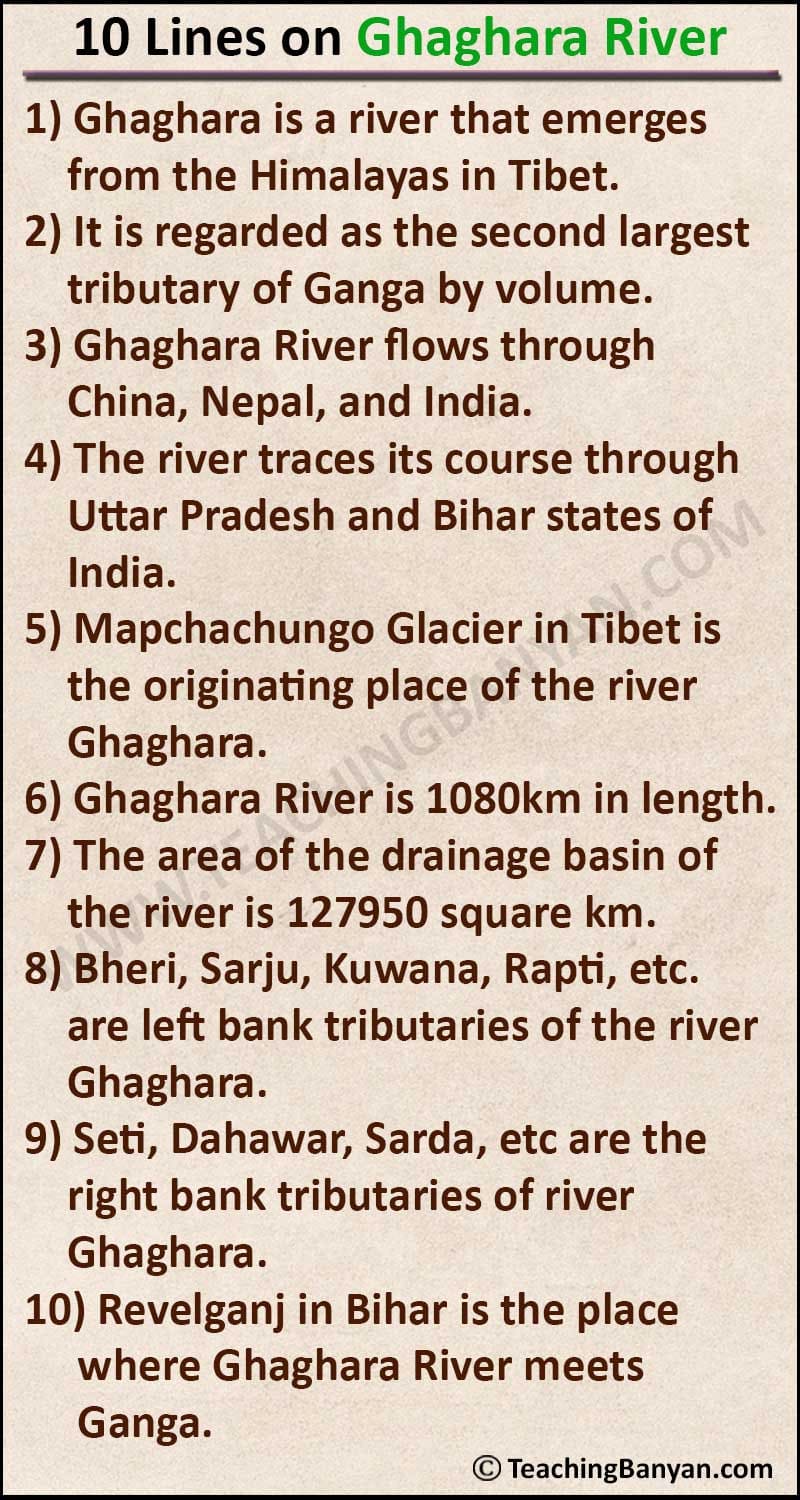Ghaghara River is one of the transboundary rivers which flows through China, Nepal and India. It is the second-largest tributary of Ganga after Yamuna. The major portion of Ghaghara River flows into India which covers the state of Uttar Pradesh and Bihar. Ghaghara River after flowing from Nepal gets separated into two parts and again joins in the south of the Indian border.
The lower stretch of Ghaghara River is known as Sarayu River where the holy city of Ayodhya, the birthplace of Lord Ram is located. Ghaghara River covers those districts of Uttar Pradesh and Bihar which are neighbouring to Nepal and it is also known as Karnali river in Nepal.
Ten Lines on Ghaghara River in English
10 Lines on Ghaghara River – Set 1
1) Ghaghara River is a trans-boundary river that is a tributary to River Ganga.
2) It is the second largest tributary of Ganga after Yamuna River.
3) The major tributaries of river Ghaghara are Kuwana, Rapti and little Gandak rivers.
4) Ghaghara River flows in the Tibet region of China, Nepal and India.
5) The total length of Ghaghara River is 1080 km and coverage area is 45,500 square km.
6) Ghaghara River originates in the high Himalayas of southern Tibet region of China.
7) After flowing from China, Ghaghara flows to the south-east of Nepal.
8) It splits into two branches that join in the south of the Indian border.
9) Lower Ghaghara River is also known as Sarayu River where Ayodhya is located.
10) Ballia, Gorakhpur, Siwan, Chhapra etc are located on the banks of Ghaghara River.
10 Lines on Ghaghara River – Set 2
1) Ghaghara is a river that emerges from the Himalayas in Tibet.
2) It is regarded as the second largest tributary of Ganga by volume.
3) Ghaghara River flows through China, Nepal, and India.
4) The river traces its course through Uttar Pradesh and Bihar states of India.
5) Mapchachungo Glacier in Tibet is the originating place of the river Ghaghara.
6) Ghaghara River is 1080km in length.
7) The area of the drainage basin of the river is 127950 square km.
8) Bheri, Sarju, Kuwana, Rapti, etc. are left bank tributaries of the river Ghaghara.
9) Seti, Dahawar, Sarda, etc are the right bank tributaries of river Ghaghara.
10) Revelganj in Bihar is the place where Ghaghara River meets Ganga.

10 Lines on Ghaghara River – Set 3
1) Ghaghara is an important river that flows in different countries.
2) Ghaghara River is spelled as Karnali in Nepal.
3) It is stated as the longest river in Nepal.
4) The length of the Ghaghara River in Nepal is 507 km.
5) Ghaghara River is the longest tributary of river Ganga after the Yamuna.
6) It is popularly called as Sarayu River in the Uttar Pradesh state of India.
7) The holy city Ayodhya is situated on the bank of river Ghaghara.
8) The name of this river has been mentioned in the great epic Ramayana.
9) Karnali River is home to marine species like Ghariyal, river dolphins, and golden mahseer.
10) Bardia National Park and Katarniaghat wildlife sanctuary are made on the river basin of river Ghaghara
10 Lines on Ghaghara River – Set 4
1) Ghaghara River is a perennial river which flows in the side of Tibet region of China, Nepal and India; it is a left bank tributary to the Ganga River.
2) Ghaghara is also known as Karnali in Nepal whereas lower Ghaghara River is also known as Sarayu River in India.
3) Ghaghara River rises in the southern part of the Himalayas in Tibet in the glaciers of Mapchachungo with the height of 3962 metres above the sea level.
4) It then flows to the south in the remotest and least explored area of Nepal in the name of Karnali River.
5) Cutting towards the south of Shivalik hills, Ghaghara River splits into two branches and re-joins on the south of the Indian border and form proper ‘Ghaghara’.
6) Ghaghara flows to the south-east through Uttar Pradesh and Bihar to join Ganga downstream of the Chhapra town in Bihar.
7) The vegetation around Ghaghara River varies from low-lying alpine trees and plants located at high elevations to tropical forests as it enters Shivalik range.
8) The famous ‘Battle of Ghaghara’ was fought in 1529 between Mughal emperor Babur against Sultan Mehmood Lodhi and Sultan Nusrat Shah of Sultanate of Bengal.
9) The ‘Katarniaghat’ wildlife sanctuary which is a part of Dudhwa tiger reserve in Uttar Pradesh in India is situated on the Ghaghara River basin.
10) The ‘Sarda Sahayak Irrigation Project’ and ‘Saryu Nahar Irrigation Scheme’ are the two irrigation projects which are running on Ghaghara River.
Various cities and districts of Uttar Pradesh and Bihar are located on the banks of Ghaghara River viz, Ambedkar Nagar, Azamgarh, Ballia, Deoria, Faizabad, Gorakhpur, Siwan, Chhapra etc. Ghaghara River is not only serving the people through water for drinking but the irrigation projects of Sarda Sahayak and Saryu Nahar are serving the people in agriculture also. The Dudhwa tiger reserve is also located on the Ghaghara River basin.
